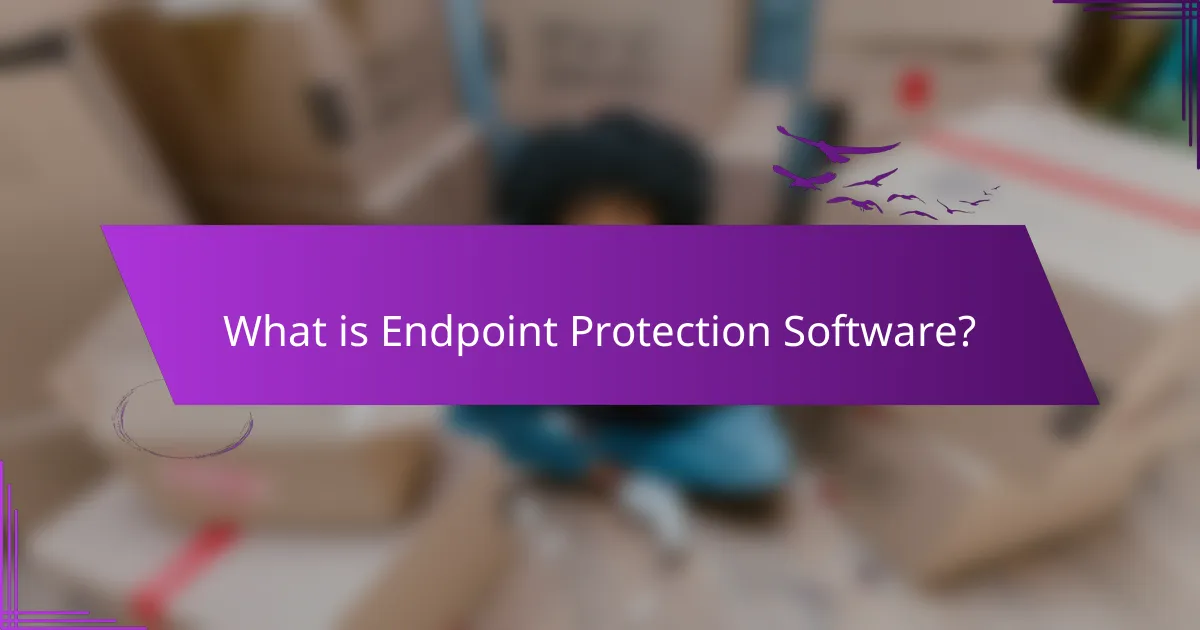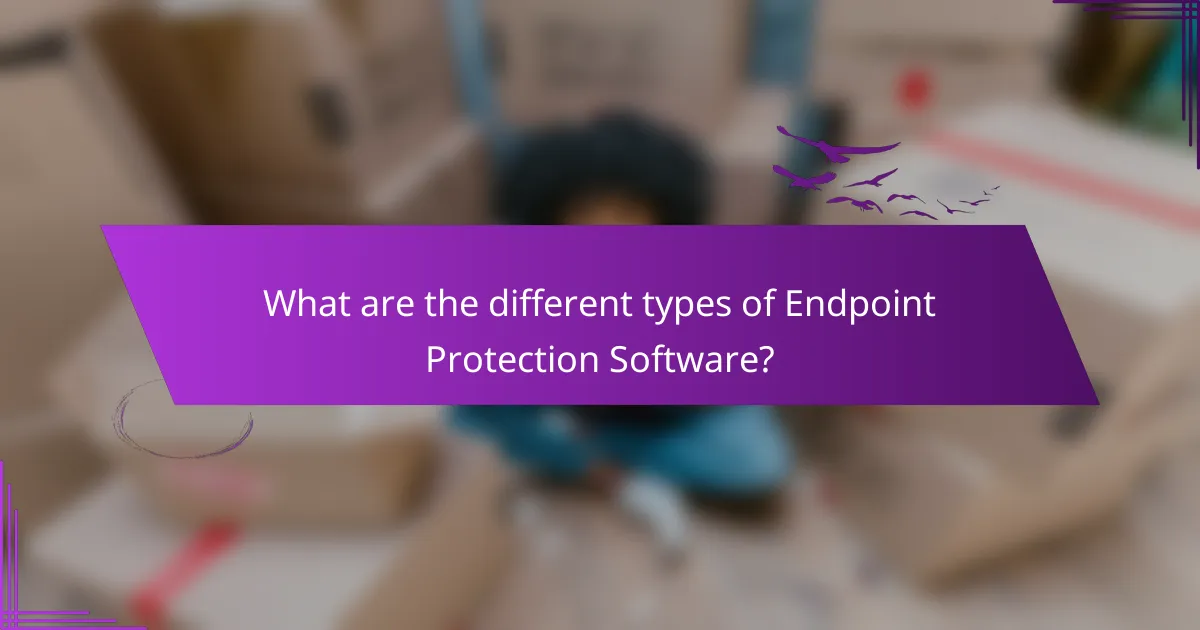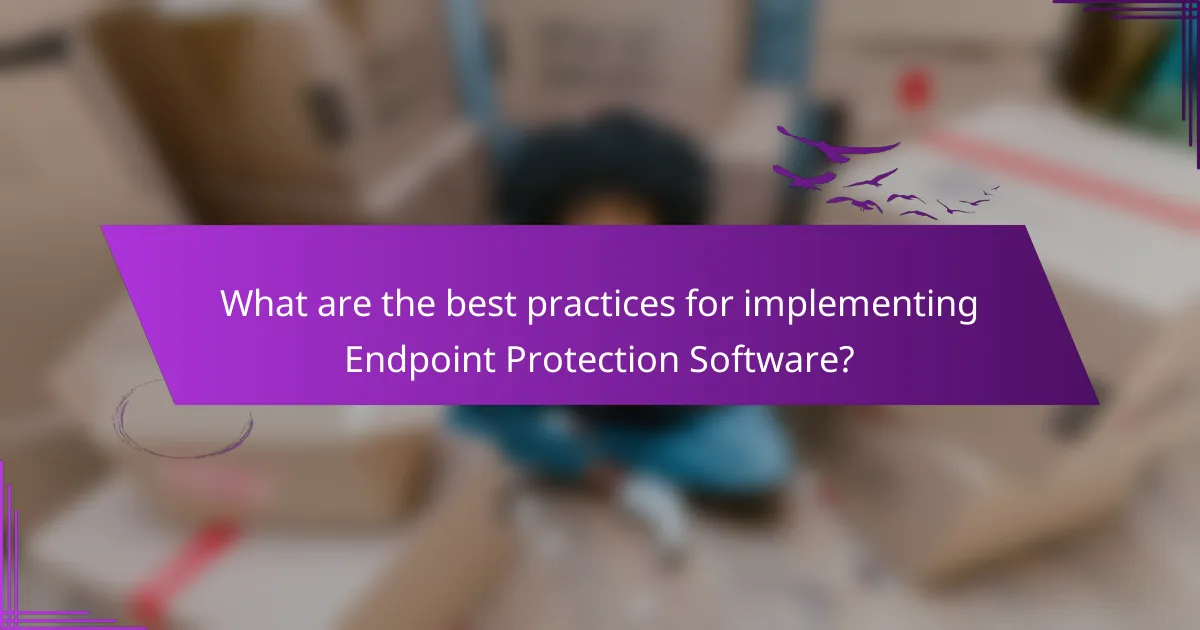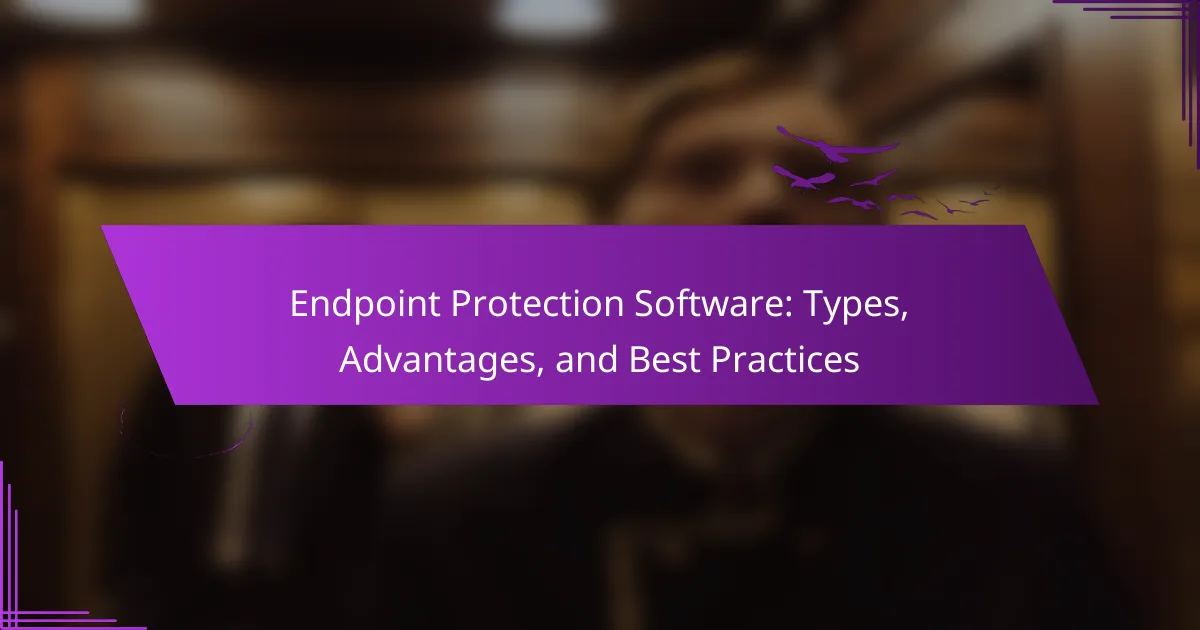
What is Endpoint Protection Software?
Endpoint protection software is a security solution designed to protect endpoint devices from cyber threats. These devices include computers, laptops, and mobile devices that connect to a network. The software monitors and manages the security of these endpoints in real-time. It typically includes features such as antivirus protection, anti-malware, and firewall capabilities. According to a report by Gartner, endpoint protection platforms can reduce the risk of data breaches significantly. This software is essential for organizations to safeguard sensitive information and ensure compliance with security regulations.
How does Endpoint Protection Software function?
Endpoint Protection Software functions by monitoring and managing endpoints to protect against cybersecurity threats. It employs various techniques such as antivirus scanning, firewall protection, and intrusion detection. These tools help identify and neutralize malware, ransomware, and other harmful software. The software continuously analyzes data traffic and user behavior for anomalies. It can also enforce security policies across devices to prevent unauthorized access. Real-time threat intelligence updates enhance its effectiveness. According to a report by Gartner, organizations using endpoint protection solutions experience a 30% reduction in security incidents. This demonstrates the software’s capability to enhance overall cybersecurity posture.
What are the key components of Endpoint Protection Software?
The key components of Endpoint Protection Software include antivirus protection, anti-malware capabilities, firewall functionality, intrusion detection systems, and data encryption. Antivirus protection scans for and removes malicious software. Anti-malware capabilities protect against various types of malware, including ransomware and spyware. Firewall functionality monitors incoming and outgoing network traffic to block unauthorized access. Intrusion detection systems identify potential threats and vulnerabilities in real-time. Data encryption secures sensitive information by converting it into an unreadable format for unauthorized users. These components work together to provide comprehensive security for endpoints, ensuring data integrity and protection against cyber threats.
How do these components interact to provide security?
Endpoint protection software components interact through a layered security approach. Each component, such as antivirus, firewall, and intrusion detection, plays a distinct role. Antivirus scans for and removes malware, while firewalls monitor and control incoming and outgoing network traffic. Intrusion detection systems identify and respond to potential threats in real-time.
These components communicate with each other to share threat intelligence. For example, if the antivirus detects malware, it can alert the firewall to block related traffic. This collaboration enhances overall system security by providing multiple defense mechanisms.
Research shows that integrated endpoint protection solutions reduce response time to threats significantly. A study by IDC found that organizations using layered security experience 50% fewer security incidents. This evidence highlights the effectiveness of component interaction in enhancing security.
What types of threats does Endpoint Protection Software defend against?
Endpoint Protection Software defends against various cyber threats. These include malware, ransomware, and phishing attacks. It also protects against spyware and adware. Additionally, it helps defend against zero-day exploits and advanced persistent threats (APTs). Endpoint Protection Software employs real-time threat detection and response mechanisms. According to a report by Cybersecurity Ventures, global cybercrime damages are projected to reach $10.5 trillion annually by 2025. This highlights the importance of robust endpoint protection in mitigating such threats.
What are the common malware types targeted by Endpoint Protection Software?
Common malware types targeted by Endpoint Protection Software include viruses, worms, and Trojans. Viruses attach themselves to legitimate files and spread when those files are shared. Worms replicate independently and can spread across networks without human intervention. Trojans disguise themselves as legitimate software to trick users into installing them. Ransomware encrypts files and demands payment for decryption. Spyware collects user data without consent, while adware displays unwanted advertisements. These malware types are prevalent threats that Endpoint Protection Software is designed to detect and mitigate.
How does Endpoint Protection Software handle phishing attacks?
Endpoint Protection Software detects and blocks phishing attacks through multiple layers of security. It employs real-time scanning to identify malicious links and attachments in emails. The software uses machine learning algorithms to analyze patterns associated with phishing attempts. It also provides user training and awareness programs to help recognize phishing tactics. Additionally, it can quarantine suspicious emails before they reach the user’s inbox. According to a report by the Anti-Phishing Working Group, organizations using such software see a significant reduction in successful phishing attacks. This multi-faceted approach ensures comprehensive protection against evolving phishing threats.
What are the core advantages of using Endpoint Protection Software?
The core advantages of using Endpoint Protection Software include enhanced security, centralized management, and proactive threat detection. Enhanced security protects endpoints from malware, ransomware, and other cyber threats. Centralized management allows IT teams to monitor and manage security across all devices from a single dashboard. Proactive threat detection identifies potential threats before they can cause harm. According to a report by Cybersecurity Ventures, endpoint protection solutions can reduce the risk of data breaches by up to 70%. These advantages collectively strengthen an organization’s overall cybersecurity posture.
How does Endpoint Protection Software enhance organizational security?
Endpoint Protection Software enhances organizational security by providing comprehensive protection against various cyber threats. It detects and responds to malware, ransomware, and phishing attacks in real-time. This software employs advanced techniques such as behavioral analysis and machine learning to identify suspicious activities. Furthermore, it centralizes security management, allowing for consistent policy enforcement across all endpoints. According to a report by Cybersecurity Ventures, organizations that implement endpoint protection solutions can reduce security incidents by up to 70%. By continuously monitoring endpoints, it ensures timely updates and threat intelligence, thereby improving overall security posture.
What cost savings can organizations expect from implementing Endpoint Protection Software?
Organizations can expect significant cost savings from implementing Endpoint Protection Software. These savings primarily arise from reduced incidents of data breaches and cyberattacks. According to a report by IBM, the average cost of a data breach is approximately $3.86 million. Effective endpoint protection can lower this risk significantly.
Additionally, organizations can save on remediation costs associated with malware infections. The average expense for recovering from such incidents can reach thousands of dollars. Endpoint Protection Software also decreases productivity losses due to downtime during security incidents.
Investing in this software can lead to a return on investment through improved compliance with regulations. Non-compliance can result in hefty fines, which endpoint protection can help mitigate. Overall, the implementation of Endpoint Protection Software can lead to substantial long-term financial benefits for organizations.

What are the different types of Endpoint Protection Software?
The different types of Endpoint Protection Software include antivirus software, anti-malware solutions, and endpoint detection and response (EDR) systems. Antivirus software primarily detects and removes malicious software. Anti-malware solutions offer broader protection against various types of threats, including ransomware and spyware. EDR systems provide advanced threat detection and response capabilities, often using machine learning and behavioral analysis. Other types include mobile device management (MDM) and data loss prevention (DLP) solutions. MDM secures and manages mobile devices within an organization. DLP focuses on preventing data breaches by monitoring and controlling data transfers. Each type addresses specific security needs for endpoints in a network.
How do traditional antivirus solutions compare to modern endpoint protection?
Traditional antivirus solutions primarily focus on detecting and removing known malware. They rely heavily on signature-based detection methods. Modern endpoint protection, however, employs advanced techniques like behavioral analysis and machine learning. This allows it to identify and mitigate unknown threats in real-time.
Traditional antivirus solutions often provide basic protection for individual devices. Modern endpoint protection offers a comprehensive security framework for entire networks. It includes features like threat intelligence, incident response, and endpoint detection and response (EDR).
Research shows that endpoint protection platforms can reduce the risk of breaches by up to 70% compared to traditional antivirus. This data highlights the effectiveness of modern solutions in today’s complex threat landscape.
What are the limitations of traditional antivirus software?
Traditional antivirus software has several limitations. It primarily relies on signature-based detection, which can miss new or unknown threats. This method struggles against advanced persistent threats and zero-day vulnerabilities. Traditional antivirus also often requires regular updates to its virus definitions. Without these updates, its effectiveness diminishes significantly. Additionally, it may not provide comprehensive protection against non-virus malware, such as ransomware or phishing attacks. User behavior can also undermine its effectiveness, as many users may disable or ignore alerts. Furthermore, traditional antivirus solutions can consume significant system resources, impacting overall performance. Lastly, they may give a false sense of security, leading users to neglect other essential security practices.
How do next-generation antivirus solutions improve upon traditional methods?
Next-generation antivirus solutions enhance traditional methods by incorporating advanced technologies like machine learning and behavioral analysis. These technologies allow for real-time detection of threats, which traditional antivirus solutions often miss. Traditional methods rely heavily on signature-based detection, which only identifies known threats. In contrast, next-generation solutions can identify previously unknown malware by analyzing behavior patterns.
For example, according to a report by AV-Test, next-generation solutions can detect 99% of malware in real-time, significantly outperforming traditional methods. Additionally, these solutions often include integrated threat intelligence, providing context and insights that improve response times. This proactive approach reduces the reliance on manual updates and improves overall security posture.
What role does Endpoint Detection and Response (EDR) play in security?
Endpoint Detection and Response (EDR) plays a critical role in security by providing continuous monitoring and response to threats on endpoints. EDR solutions detect suspicious activities and potential threats in real-time. They collect and analyze data from endpoints to identify anomalies. This allows for rapid response to incidents, minimizing damage. EDR enhances threat hunting capabilities by providing detailed insights into attacks. According to a report by Gartner, EDR solutions can reduce the time to detect and respond to breaches significantly. Implementing EDR can lead to a more proactive security posture for organizations.
How does EDR differ from traditional endpoint protection?
EDR, or Endpoint Detection and Response, differs from traditional endpoint protection by focusing on real-time monitoring and response to threats. Traditional endpoint protection primarily relies on signature-based detection methods. It scans for known malware and blocks it based on established signatures. In contrast, EDR utilizes behavioral analysis to identify suspicious activities. This allows for the detection of advanced threats that may bypass traditional defenses. EDR also provides incident response capabilities, enabling security teams to investigate and remediate threats effectively. According to a report by Gartner, EDR solutions are essential for organizations facing sophisticated cyber threats.
What are the benefits of integrating EDR with existing security solutions?
Integrating Endpoint Detection and Response (EDR) with existing security solutions enhances overall cybersecurity effectiveness. It provides real-time threat detection and automated response capabilities. EDR systems analyze endpoint activities for suspicious behavior. This integration allows for a more comprehensive view of security incidents. It improves incident response times by automating remediation processes. According to a report by Gartner, organizations that integrate EDR see a 50% reduction in response times. Enhanced visibility across the network is another key benefit. EDR solutions collect and correlate data from multiple endpoints. This leads to better threat intelligence and informed decision-making.
What specialized types of Endpoint Protection Software exist?
Specialized types of Endpoint Protection Software include antivirus software, anti-malware solutions, and endpoint detection and response (EDR) systems. Antivirus software focuses on detecting and removing viruses and other malicious software. Anti-malware solutions provide broader protection against various types of malware, including spyware and ransomware. EDR systems offer advanced threat detection and response capabilities, monitoring endpoints for suspicious activities. Additionally, mobile device management (MDM) solutions secure and manage mobile devices in the enterprise environment. Each type addresses specific security needs and enhances overall endpoint protection.
How do mobile device management (MDM) solutions enhance endpoint security?
Mobile device management (MDM) solutions enhance endpoint security by enforcing security policies on devices. They provide centralized management for device configurations and updates. MDM solutions can remotely wipe data from lost or stolen devices. They enable strong authentication methods to prevent unauthorized access. MDM also facilitates the deployment of security applications across devices. These solutions monitor device compliance with security standards. They generate alerts for suspicious activities or policy violations. According to a study by Gartner, organizations using MDM can reduce security breaches by up to 70%.
What are the unique features of cloud-based endpoint protection solutions?
Cloud-based endpoint protection solutions offer unique features such as centralized management and real-time threat intelligence. These solutions enable organizations to manage security policies across multiple devices from a single console. They utilize cloud infrastructure to provide scalability and flexibility, allowing for rapid deployment. Cloud-based solutions often include automated updates, ensuring that protection is always current against the latest threats. Additionally, they leverage machine learning algorithms to enhance threat detection capabilities. This approach allows for quicker response times to emerging threats. According to a report by Gartner, cloud-based endpoint protection can reduce operational costs by up to 30%.

What are the best practices for implementing Endpoint Protection Software?
Implementing Endpoint Protection Software requires a structured approach. First, conduct a thorough risk assessment to identify vulnerabilities. This helps in selecting appropriate software tailored to specific needs. Next, ensure software is regularly updated to protect against the latest threats. Regular updates address newly discovered vulnerabilities and improve overall security.
Training employees is also crucial. Educated users are less likely to fall for phishing attacks or other social engineering tactics. Additionally, configure the software to enforce security policies consistently across all endpoints. This includes setting up firewalls and intrusion detection systems.
Regular monitoring and reporting on endpoint activity are essential. This allows for quick detection of suspicious behavior. Finally, conduct periodic reviews of the endpoint protection strategy. This ensures that it evolves with changing threats and organizational needs. Following these best practices enhances the effectiveness of Endpoint Protection Software.
How should organizations assess their endpoint protection needs?
Organizations should assess their endpoint protection needs by evaluating their specific security requirements. This involves identifying the types of devices used within the organization. Each device type may have different vulnerabilities and security needs.
Next, organizations should analyze their threat landscape. Understanding potential threats helps in selecting appropriate protection measures. They should also consider regulatory compliance requirements that may dictate specific security protocols.
Additionally, organizations should conduct a risk assessment to identify critical assets and potential impacts of security breaches. This assessment informs the level of protection needed for each endpoint.
Finally, organizations should review existing security solutions and their effectiveness. This evaluation ensures that current measures align with identified needs and threats. Regular assessments help organizations adapt to evolving security challenges.
What factors should be considered when choosing Endpoint Protection Software?
When choosing Endpoint Protection Software, consider effectiveness against threats. Evaluate the software’s detection and response capabilities. Look for features like real-time monitoring and threat intelligence. Assess the software’s compatibility with existing systems. Check for scalability to accommodate future growth. Review the vendor’s reputation and customer support options. Analyze pricing models to ensure they fit your budget. Research compliance with industry regulations to maintain security standards.
How can organizations evaluate the effectiveness of their endpoint protection solutions?
Organizations can evaluate the effectiveness of their endpoint protection solutions through various methods. They can conduct regular security assessments to identify vulnerabilities. Implementing [censured] testing can simulate attacks to measure defense capabilities. Monitoring threat detection rates provides insight into how well the solution identifies malicious activities. Analyzing incident response times helps assess how quickly threats are mitigated. Reviewing compliance with industry standards ensures alignment with best practices. Gathering user feedback can highlight usability and effectiveness from an operational perspective. Lastly, tracking the number of security breaches pre- and post-implementation offers concrete evidence of improvement.
What are the common pitfalls to avoid when using Endpoint Protection Software?
Common pitfalls to avoid when using Endpoint Protection Software include inadequate configuration, which can leave systems vulnerable. Failing to update the software regularly can result in exposure to new threats. Relying solely on endpoint protection without additional security layers is another mistake. Neglecting user training can lead to human errors that compromise security. Overlooking the importance of monitoring alerts can result in missed threats. Not assessing the effectiveness of the software periodically can leave gaps in protection. Lastly, ignoring compatibility issues with existing systems can hinder performance and security.
How can misconfigurations lead to security vulnerabilities?
Misconfigurations can lead to security vulnerabilities by creating unintended access points in systems. Incorrect settings may allow unauthorized users to gain access to sensitive data. For example, default passwords left unchanged can be easily exploited. Additionally, misconfigured firewalls may fail to block malicious traffic. This can result in data breaches or system compromises. Research shows that 70% of security incidents are due to misconfigurations. Organizations must regularly audit configurations to mitigate these risks. Proper configuration management is essential for maintaining security integrity.
What role does employee training play in maximizing endpoint protection effectiveness?
Employee training plays a crucial role in maximizing endpoint protection effectiveness. It equips employees with the knowledge to recognize and mitigate security threats. Trained employees are less likely to fall victim to phishing attacks and malware. According to a report by IBM, human error accounts for 95% of cybersecurity incidents. Regular training updates keep staff informed about the latest threats and best practices. Organizations with comprehensive training programs experience fewer security breaches. This proactive approach enhances the overall security posture of the organization.
What are some practical tips for maintaining effective Endpoint Protection Software?
Regularly update the Endpoint Protection Software to ensure it has the latest security patches. This practice helps protect against newly discovered vulnerabilities. Schedule automatic updates to minimize the risk of outdated software. Conduct regular scans to identify and eliminate threats. Frequent scans can detect malware that may have bypassed existing defenses. Configure alerts for suspicious activities to respond promptly. Implement strong password policies to enhance security. Educate users about phishing attacks and safe browsing habits. Training users can significantly reduce the risk of human error leading to security breaches.
Endpoint Protection Software is a crucial security solution designed to safeguard endpoint devices, including computers and mobile devices, from various cyber threats. This article covers the functionality, key components, and types of endpoint protection software, highlighting their effectiveness against malware, ransomware, and phishing attacks. It also discusses the advantages of implementing such software, best practices for deployment, and the significance of employee training in enhancing security measures. Additionally, the article explores the differences between traditional antivirus solutions and modern endpoint protection, emphasizing the importance of integrating advanced technologies like Endpoint Detection and Response (EDR) for comprehensive security.
